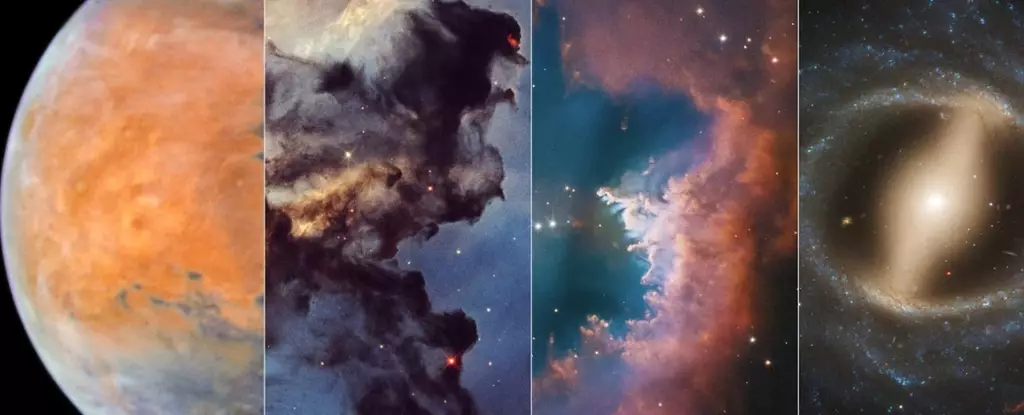This week, the astronomical community celebrates a milestone: the 35th anniversary of the Hubble Space Telescope’s launch. Since its deployment on April 24, 1990, aboard the Space Shuttle Discovery, Hubble has not simply been a telescope but a pivotal astronomic vessel, reshaping our understanding of the universe. Instead of receiving gifts for this special occasion, the scientists involved with Hubble are offering us breathtaking images, ranging from striking details of Mars to captivating views of distant galaxies. This annual release of images exemplifies a long-standing tradition at NASA and the Space Telescope Science Institute to commemorate Hubble’s launch by satisfying our innate curiosity about the cosmos.
A Troubled Beginning
Hubble’s journey has not always been smooth sailing. Upon its arrival in space, it was plagued by a manufacturing flaw in its primary mirror, which significantly affected image clarity. This catastrophic error could have spelled doom for the mission. However, in 1993, NASA launched a servicing mission that forever changed the trajectory of Hubble’s contributions to science. Astronauts installed corrective hardware that honed the telescope’s imaging capabilities, allowing it to fulfill its astronomical potential. This incident underscores the resilience of both the Hubble team and the technology behind it—a testament to human ingenuity and the relentless pursuit of knowledge.
The Scientific Renaissance
Since overcoming its initial obstacles, Hubble has played a crucial role in countless astronomical discoveries. Its observations have revolutionized our understanding of phenomena like exoplanets, black holes, and the nature of dark energy. The telescope’s data have contributed to groundbreaking research, resulting in over 22,000 published papers—an astonishing figure that reflects its significance within the scientific community. Whether it’s revealing the accelerating expansion of the universe or probing the secrets of the early cosmos, Hubble has positioned itself as a cornerstone of modern astrophysics.
The statistics further bolster its impact: with nearly 1.7 million observations directed at approximately 55,000 celestial bodies, the telescope has yielded a wealth of knowledge that shapes current astronomical paradigms. Hubble’s ability to be both a tool for discovery and a canvas for public engagement has endeared it to enthusiasts and laypeople alike, making it a symbol of human achievement in the realm of space exploration.
Challenges and Triumphs
However, not all has been rosy in Hubble’s storied history. The devastating loss of the Space Shuttle Columbia and its crew in 2003 led to a suspension of vital maintenance plans for the telescope. The outcry for Hubble’s continued operation prompted NASA to initiate a final servicing mission in 2009, which turned out to be a remarkable success. Originally expected to extend Hubble’s operational life by just a few additional years, this undertaking instead yielded an unexpected 16 years of fruitful exploration post-maintenance, reigniting the world’s fascination with space imagery.
As of now, Hubble continues to exhibit occasional technical hiccups, serving as a reminder that even the most advanced technologies are not infallible. Yet, amidst these troubled moments, Hubble has demonstrated an indomitable spirit, pushing the boundaries of what we understand about our universe.
Current Endeavors and Looking Ahead
Among the latest highlights are exquisite images that showcase various celestial phenomena, including Martian landscapes captured as the planet neared Earth in December and stunning portraits of cosmic nebulae. Such images not only captivate the imagination but also solidify Hubble’s role as a cornerstone of ongoing research endeavors. For instance, studying dynamic environments like the Rosette Nebula and monitoring structures in prominent galaxies such as NGC 5335 reveals processes of star formation that have pivotal implications for our understanding of galactic evolution.
Another essential aspect of the future of space observatories lies in the rise of the James Webb Space Telescope (JWST). Launched in 2021, JWST offers advantages that complement Hubble’s capabilities. With its primary function to observe the universe primarily in infrared wavelengths, JWST dramatically expands our capacity to explore the cosmos by revealing previously hidden details. However, its inability to undergo servicing or repairs in orbit highlights some inherent limitations compared to Hubble’s design.
Looking forward, NASA is gearing up for another ambitious project—the Habitable Worlds Observatory (HWO). Slated for potential launch in the 2040s, the HWO promises to advance our quest for knowledge by identifying Earth-like exoplanets in habitable zones. By equipping this future telescope with robotic servicing technology, similar to Hubble’s legacy, NASA aims to ensure a sustained and enhanced exploration of the universe.
The 35th birthday of the Hubble Space Telescope is not merely a celebration of technology but a testament to human curiosity and the relentless pursuit of understanding our existence in the cosmos. The stories and discoveries it has contributed will undoubtedly lay the groundwork for future astronomical endeavors, inspiring generations to look up and wonder about the universe beyond our reach.

